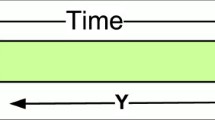Abstract
This article investigates the behavior of the cognitive queueing system in a spectrum-sharing environment under the primary outage probability constraint. The queueing model is investigated under two cognitive transmit modes. A variable transmit rate that is equal to the cognitive channel’s capacity is first revisited, then the case of constant transmit rate is considered. Both transmit modes are found to lead to an \(M/G/1\) queueing model. The performance measures of the cognitive queue under these two modes are investigated and numerically compared. The performance measures include the mean transmit rate, mean service time, server utilization, mean waiting and transit times of the packets in the queue, mean number of waiting and transit packets in the queue, mean duration of the server’s busy period, and mean number of packets served during the server’s busy period. The effects of changing the primary outage probability constraint and the primary transmit rate on the performance measures are investigated as well.









Similar content being viewed by others
References
Federal Commununications Commission. (2002, November). Spectrum policy task force report. ET Docket No. 02-135.
Mitola, J. (2000, December). Cognitive radio: An integrated agent architecture for software defined radio. Ph.D. thesis, Royal Institute of Technology (KTH), Stockholm, Sweden.
Haykin, S. (2005). Cognitive radio: Brain-empowered wireless communications. IEEE Journal on Selected Areas in Communications, 23, 201–220.
Farraj, A. K., & Hammad, E. M. (2013). Performance of primary users in spectrum sharing cognitive radio environment. Wireless Personal Communications, 68, 575–585.
Kim, S. (2013). Cognitive radio bandwidth sharing scheme based on the two-way matching game. Wireless Personal Communications, 68, 893–905.
da Costa, D., Aïssa, S., & Cavalcante, C. (2012). Performance analysis of partial relay selection in cooperative spectrum sharing systems. Wireless Personal Communications, 64, 79–92.
Ciftci, S., & Torlak, M. (2013). A comparison of energy detectability models for cognitive radios in fading environments. Wireless Personal Communications, 68, 553–574.
Farraj, A. K., & Hammad, E. M. (2013). Impact of quality of service constraints on the performance of spectrum sharing cognitive users. Wireless Personal Communications, 69, 673–688.
Su, H., & Zhang, X. (2008). Cross-layer based opportunistic MAC protocols for QoS provisionings over cognitive radio wireless networks. IEEE Journal on Selected Areas in Communications, 26, 118–129.
Su, H. & Zhang, X. (2009, October). Adaptive uplink MAC for CDMA-based cognitive radio networks. In IEEE military communications conference (MILCOM), pp. 1–7.
Du, Q., & Zhang, X. (2010, May) Queue-aware spectrum sensing for interference-constrained transmissions in cognitive radio networks. In IEEE international conference on communications (ICC), pp. 1–5.
Wang, L.-C., Wang, C.-W., & Adachi, F. (2011). Load-balancing spectrum decision for cognitive radio networks. IEEE Journal on Selected Areas in Communications, 29, 757–769.
El-Sherif, A. A., & Liu, K. J. R. (2011). Joint design of spectrum sensing and channel access in cognitive radio networks. IEEE Transactions on Wireless Communications, 10, 1743–1753.
Zhang, Y. (2008, May). Dynamic spectrum access in cognitive radio wireless Networks. In IEEE international conference on communications (ICC), pp. 4927–4932.
Shiang, H.-P., & van der Schaar, M. (2008). Queuing-based dynamic channel selection for heterogeneous multimedia applications over cognitive radio networks. IEEE Transactions on Multimedia, 10, 896–909.
Zhang, C. Wang, X., & Li, J. (2009, June). Cooperative cognitive radio with priority queueing analysis. In IEEE international conference on communications (ICC), pp. 1–5.
Rashid, M. M., Hossain, M. J., Hossain, E., & Bhargava, V. K. (2009). Opportunistic spectrum scheduling for multiuser cognitive radio: A queueing analysis. IEEE Transactions on Wireless Communications, 8, 5259–5269.
Farraj, A. K., Miller, S. L., & Qaraqe, K. A. (2011, December).Queue performance measures for cognitive radios in spectrum sharing systems. In IEEE international workshop on recent advances in cognitive communications and networking (RACCN)—Global telecommunications conference (GLOBECOM) workshop, pp. 997–1001.
Chu, T. M. C., Phan, H., & Zepernick, H.-J. (2013). On the performance of underlay cognitive radio networks using M/G/1/K queueing model. IEEE Communications Letters, 99, 1–4.
Goldsmith, A. (2005). Wireless Communications (1st ed.). Cambridge: Cambridge University Press.
Bolch, G., Greiner, S., de Meer, H., & Trivedi, K. S. (2006). Queueing networks and Markov chains: Modeling and performance evaluation with computer science applications (2nd ed.). Hoboken, NJ: Wiley-Blackwell.
Cover, T. M., & Thomas, J. A. (1991). Elements of information theory (1st ed.). New York: John Wiley & Sons.
Miller, S. L., & Childers, D. G. (2004). Probability and random processes: With applications to signal processing and communications (1st ed.). Amsterdam: Elsevier Academic Press.
Giambene, G. (2005). Queuing theory and telecommunications: Networks and applications. New York: Springer-Verlag.
Adan, I., & Resing, J. (2001). Queueing theory. Available online at http://www.cs.duke.edu/~fishhai/misc/queue.pdf.
Little, J. D. C. (1961). A proof of the queuing formula: \(L = \lambda W\). Operations Research, 9, 383–387.
Ma, Z., & Xu, Q. (2008). General decrementing service M/G/1 queue with multiple adaptive vacations. Applied Mathematics and Computation, 204, 478–484.
Author information
Authors and Affiliations
Corresponding author
Rights and permissions
About this article
Cite this article
Farraj, A.K. Queue Model Analysis for Spectrum-Sharing Cognitive Systems Under Outage Probability Constraint. Wireless Pers Commun 73, 1021–1035 (2013). https://doi.org/10.1007/s11277-013-1245-2
Published:
Issue Date:
DOI: https://doi.org/10.1007/s11277-013-1245-2




